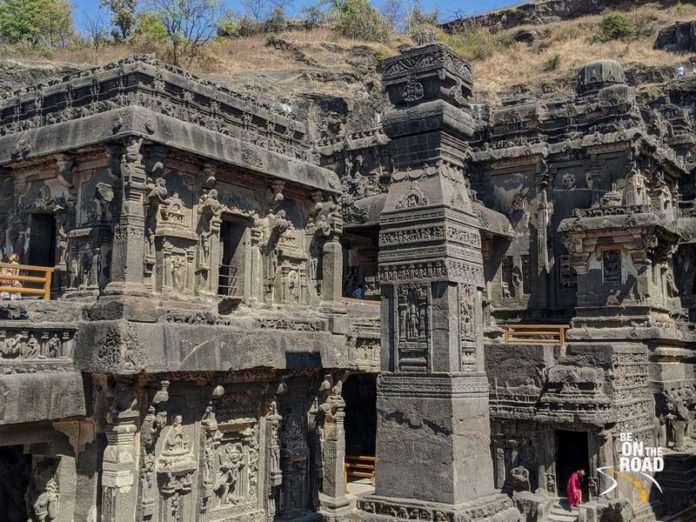As the morning sun rays kiss the land of Aurangabad, the gleam of the day reflects in the splendor and vivacity of the walls of the ultimate architectural marvels of Ellora. Amidst all the magnificent caves and the curiosity-invoking structures of an erstwhile civilization, there stands a majestic temple that has perplexed architects and engineers for centuries together. Not a single person in the world has a clear idea of how this enigmatic temple dedicated to Lord Shiva had been constructed and how it came into being during an age when the advanced civil engineering concepts had not been invented yet.
Welcome to a rendezvous with the Kailashanatha Temple, also called Kailasha Temple, which sits nestled in quaint Charanandri Hills of Ellora, as the largest rock-cut Hindu temple in the world. No megalith around the globe can match the grandeur and the architectural brilliance that the Kailasha Temple exudes. The temple carved from a rock cliff face not only impresses the visitors with its sculptural treatment but also conceals innumerable secrets of civil engineering that researchers are still struggling to decipher. No wonder the temple dedicated to one of the highest Gods of Hinduism is also the supreme architectural masterpiece that stands unparalleled in the world.
Completed in the 8th Century C.E., the temple is believed to be made from a single rock. Marked as Cave 16 among the 34 Jain, Buddhist, and Hindu cave temples of Ellora, the temple has two epigraphs attributing its construction to the Rashtrakuta dynasty king, Krishna I, which implies its origins belong to circa 756-773 AD. However, it will be a rash decision to credit the temple’s glory entirely to the Rashtrakuta kingdom, as a few temples located close to the main structure bear traces of Chalukya and Pallava art culture. Therefore, one can say with certainty that the Kailasha Temple is a confluence of cultures and art styles, while also being a testament to the cultural tolerance of the erstwhile times. It is said that a beautiful multitude of free-standing sculptures and reliefs of a grandiose architectural rendition once stood as companions of the main temple, though the vagaries of time have eroded them into oblivion.
Before one can enter the temple to pay reverence to the Almighty and to bask in its excellence, one needs to first have a tryst with its glorious history that acquaints visitors with the spellbinding past of the temple. A copper plate inscription in Vadodara, which dates to 812-813 C.E., mentions Krishnaraja I as the patron of the Kailasha Temple at Elapura (present-day Ellora) and states that the temple was so magnificent that even the Gods and highest of architects were astonished. Those who have an eye for architectural detail will notice that the temple boasts of several distinct sculptural and architectural styles, which narrate the legacy of multiple reigns that have contributed to the completion of the large temple complex. If one happens to visit the other structures at Ellora, one will find that several features visible in Cave 15, i.e. Dashavatara Cave, have been replicated in Kailasha Temple too. However, archaeological analysis says that Cave 15 (a predecessor to Kailasha Temple) bears an inscription to Dantidurga, who was the predecessor of Krishna I. As a result, some historians tend to believe that it must have been Dantidurga who commenced the work on Kailasha Temple too, but Krishna I consecrated its first complete version, which was much smaller than the marvelous megalith that sits in Ellora today. However, after the demise of Krishna I, the later kings – Dhruva Dharavarsha, Govinda III, Amoghavarsha, and Krishna III – expanded the temple to its present-day glory. The opulence of this mesmerizing temple enchanted the minds of other kingdoms too, as Paramara ruler, Bhoja, added a new layer of paintings and commissioned an elephant-lion frieze situated on the lower plinth of the temple, during his invasion of Deccan India. Every great king seems to have felt a compelling desire to add his contributions to the eminence of the temple.
Having exalted in the majestic history of the temple, let’s now enter the premises and with blessings of the Almighty, let’s unveil a few more spectacles of the man-made wonder. As one roams around the temple, one will notice that the main shrine of the temple bears a canny resemblance to the Virupaksha Temple of Pattadakal, which is itself a replica of the Kanchi-based Kailasha Temple. Visitors’ eyes usually light up once they learn that the Virupaksha Temple was built by the Chalukyas to celebrate their victory over the Pallavas. No wonder why Krishna I would have been eager about constructing a mega replica of the Virupaksha Temple by its very sculptors, after having conquered over Chalukyas in a battle. Here is another catch. If the architects of the Virupaksha Temple were the working hands behind the Kailasha Temple of Ellora, then the temple could have been constructed within a single king’s reign, as they already had the blueprint. This stands as a mystery even today since no one is entirely sure how long it took to complete the temple’s construction.
The grandness of the west-facing temple has much more to it. The peak of the superstructure stands 32.6 meters above the court level below. Its architecture comprises the vimana – the superstructure over the garbhagriha, while a closed hall (gudhamandapa) and a four-pillared entry porch (mukhacatuski) rest below it. The sub-shrine deities, also called astaparivaralaya, sit around the central shrine. The astaparivaralaya consists of two karnavimanas, meaning minor vimanas positioned, along the diagonal axes of the vimana. Besides, three bhadra vimanas, implying minor vimana on the main vimana’s central axes, two ghana devakulikas (i.e. appliqued shrine with a false door), a nandimandapa, and a prakara with a gopuram are located to the west. Nandimandapa implies a pavilion for Shiva’s sacred mount, Nandi. Prakara is an enclosure wall and Gopuram is a colossal tower situated at the entrance of a Hindu temple.
One can pay reverence to the holy rivers, Ganga and Yamuna at the temple, as the auspicious complex comprises shrines for the river Goddesses. A sacrificial enclosure, yajnashala, and a complex on Paralanka (a suburb of Lanka as mentioned in Ramayana) are situated to the south. Ardent devotees of Lord Shiva will be delighted to find here the various forms of Shiva, like Samharamurti (the aggressive form), Nrittamurti (the dancer form) Anugrahamurti (the benign form), and a mentor form of Shiva.
Wall paintings at the temple are a blessing to lovers of mythology. The tales of Andhakasuravadha and Gajataka, along with other stories from Shiv Mahapuran have been intricately recited through visualizations. The annihilation of the three cities of demons by Lord Shiva has also been painted on the walls of the temple.
Now that you are soaked in veneration for the temple, let’s encounter its biggest mystery – its method of construction. The temple stands as the jewel in the crown of architecture because of its supposed vertical excavation. This means the rock carvers began at the top of the original rock and chiseled the rock downwards, which suggests that the top of the temple was constructed before the base could be. Doesn’t that tickle the imagination a bit too much? Isn’t that perplexing to even the most intelligent of minds? Scientists, historians, and civil engineers have been confounded at the architectural marvel ever since this fact about the temple has been unveiled. No one today can even imagine having such a top-down construction done with whatever machinery the technologically advanced world has.
A Marathi legend by Krishna Yajnavalki, Katha Kalapataru, has it that the temple was a result of the fulfillment of a queen’s wish. As the legend narrates, a local king was suffering from a severe fatal disease, which was cured by God Grishneshwar (Lord Shiva) only after his queen prayed to Him for mercy. She vowed to construct a temple in lieu of her husband’s good health and vowed a fast until the temple’s peak – the shikhara – could be seen. After the king got well, he realized that the construction of a temple of a grand scale would take months to complete. That is when an architect, named Kokasa, promised to bring up the shikhara within a week for the queen to fulfill her vow and therefore began constructing the temple vertically downwards. Historians attribute Kokasa to be the chief architect of the megalith temple.
As one enters the temple’s courtyard, a low gopuram welcomes the visitors. Figurines of deities flank both sides of the entrance. The deities on the left side are mostly Shaivite, while on the right side of the entrance, a majority of Vaishnavaite deities are placed. The two-storeyed gateways lead to a U-shaped courtyard that measures around 82 meters by 46 meters at the base. A three-storeyed columned arcade marks the boundaries of the courtyard. The arcades are punctuated by massive sculpted panels, alongside the alcoves that house a diversity of deities. History has it that large flying stone bridges once connected the galleries to the central structure of the temple. However, with time, these bridges have now dilapidated and all that is visible is the assortment of famous sculptures of Lord Shiva.
Inside the mesmerizing courtyard, there rests a central shrine dedicated to Lord Shiva and an image of his mount, Nandi. Housing a sacred ‘lingam’, the flat-roofed mandapa stands supported by 16 ornate pillars, while the shikhara displays the magnificence of the Dravidian architecture. An assortment of pillars, rooms, ancient windows, gathering halls, and a giant stone lingam inspire reverence in the minds of the visitors. On the lower stories of the Nandi Mandapa, one can witness the splendor of intricate illustrative carvings. And finally, at the base of the temple, carvings of elephants are visible that symbolize the temple being held aloft by the elephants. All around the base of the temple, one can find panels and features narrating tales from the Ramayana and the Mahabharata. One cannot miss noticing one sculpture recounting the mythological tale of Ravana attempting to lift the Mount Kailasha.
However, knowing its recorded past is equivalent to just scratching the surface of the enigma of Kailasha Temple so far. The monolithic architectural marvel shrouds countless mysteries within itself, which the entire human civilization is still fascinated with. The first is the dilemma on the exact science behind its construction. The single-massive rock was cut approximately 50 meters in the back, while 2,00,000 tonnes of rock would have been removed to give the temple its shape. This should have easily taken more than a hundred years if the architectural technology of those times is to be considered. However, recorded history claims the temple took only 18 years for its completion. Even modern engineers may find it arduous to achieve such a feat. The claimed speed of the temple’s construction continues to baffle scientists, historians, and devotees alike.
It is also said that the artists of those times had plastered the entire temple in white, to ensure its resemblance to Mount Kailash. The pyramidal structure of the temple was also intended to mimic the holy Himalayan mountain. The Kailasha Temple, which is double the size of the Parthenon in Athens, has stunned architects around the world on how multi-storeyed complexes could be built from a single rock, through vertical excavation. The convergence of Buddhist, Jain, and Hindu art styles in the Kailasha Temple has also been a major highlight of the architectural marvel, as it is believed that priests sanctified the rock by chanting mantras and performed a Mahayagna according to the Vedic traditions. One can hear the divine language of devotion chiming in the ancient pillars that have their legacy to boast of. And not to forget the largest cantilevered rock ceiling in this temple that ideally must have been an impossible feat to achieve thousands of years ago. Last but not the least, the unique narrow shafts, holes, and lanes that have been drilled in the temple complex still stun the historians with their preciseness.
What stuns people all the more about this temple is its invincibility to the assault of time and barbarians. In 1682, the Mughal king, Aurangzeb specifically hired 1,000 workers for the exclusive job of destroying the temple. What the workers and their monarch faced was utter disappointment, frustration, and defeat. The maximum damage they could do was the distortion of a few carvings, while the temple stood as a symbol of the indomitability of Vedic architecture.
The architects of today know every small detail of their blueprints and know what each small component does. However, the Kailasha Temple teems with small holes, passages, and tunnels that still mystify the architects and civil engineers. No one seems to understand the purpose of these passages, though many suspect that these could have acted as air vents for ventilation. The wall paintings also depict tiny humanoids living in the underground civilizations. Though cave 16 has been confirmed to be the oldest among all caves, yet the design of the temple looks the most advanced of all. People are baffled as to why no other temple in Ellora displays such advanced architectural feats. No doubt why the temple is still shrouded in a veil of mystery for centuries.
One can comfortably argue that the Kailasha Temple is so far the most mysterious and stupefying architectural marvel that can astound any visitor who comes before it. The incredible architectural wonder sits in Ellora with its dominion of 31 other caves that inspire awe and perplexity in the minds of visitors who come from distant lands to witness the grandeur in the Charanandri Hills. It is the Kailasha Temple of Ellora that wears the crown of the greatest architectural marvel in the world.
By Arijit Goswami, Mohali
















